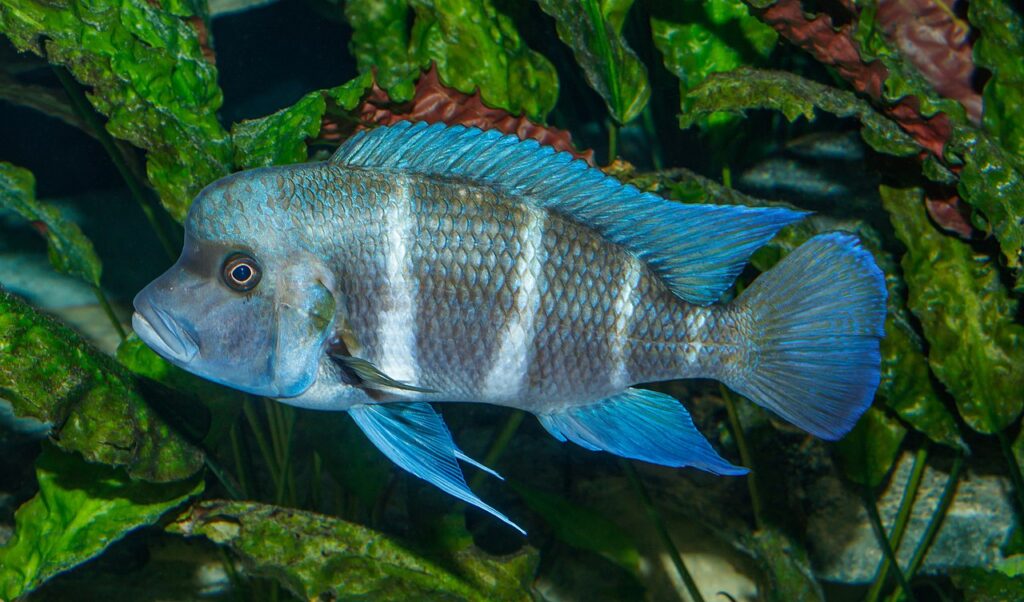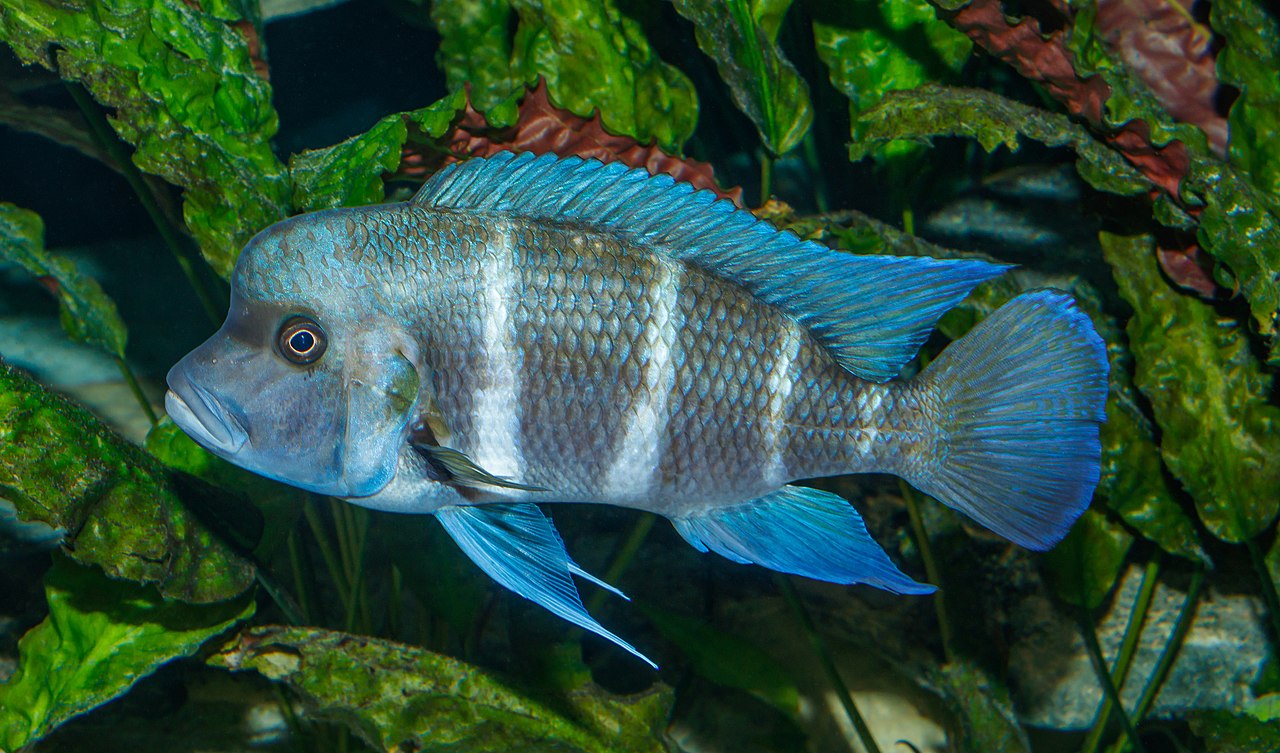Frontosa Cichlids, scientifically known as Cyphotilapia frontosa, offer an aquatic spectacle for any fish enthusiast. Originating from the depths of Lake Tanganyika in East Africa, these captivating creatures are a testament to nature’s artistry. Noted for their striking blue and black bodies adorned with contrasting stripes, they bring a unique aesthetic to any aquarium.
Table of Contents
A noteworthy fact about Frontosa Cichlids is their lifespan, extending up to 25 years in captivity. This longevity, coupled with their fascinating behavior, makes them a long-term companion for dedicated aquarists. Interestingly, their behavior is as distinctive as their appearance. Known as bottom to mid-water dwellers, these fish exhibit a peaceful demeanor, though they can be territorial among their own species.
Frontosa Cichlids are not considered rare but hold a special place in the hearts of fish keepers. Among the most popular variants are those characterized by the number and vibrancy of their stripes, which vary based on their specific location in Lake Tanganyika.
Their diet in captivity reflects their predatory nature in the wild. They thrive on a variety of foods including pellets, frozen, and live foods, making their dietary needs straightforward for aquarists. The male Frontosa, with a more pronounced frontal hump, is particularly striking, a feature that becomes more evident as the fish matures.
Diving into their history, Frontosa Cichlids have been a part of the aquarium trade for decades, witnessing a surge in popularity in the 1990s. This rise in interest can be attributed to the increased availability of various striking variants, capturing the attention of fish enthusiasts worldwide.
In terms of tank mates, selecting the right companions is crucial. Due to their size and temperament, they are best paired with peaceful yet sizable fish to prevent them from being seen as prey.
A fascinating aspect of these cichlids is their breeding behavior. They are mouthbrooders, with the female carrying fertilized eggs and fry in her mouth to ensure their protection, a remarkable display of parental care in the aquatic world.
Regarding tank setup, a minimum of 75 gallons is recommended for a small group of Frontosa Cichlids. They prefer alkaline water with a pH of 7.8-9.0 and a temperature range of 72-82°F. The ideal habitat should mimic their natural environment with a sandy bottom and rock formations.
In conclusion, Frontosa Cichlids, with their unique appearance and fascinating behavior, are a jewel in the aquarium hobby. Their care requires attention and dedication, but the reward is a truly mesmerizing aquatic experience.

Key Information
Frontosa Cichlids, or Cyphotilapia frontosa, are renowned for their striking variants which are primarily distinguished by their stripe patterns and coloration. These variants, often linked to their specific geographic location in Lake Tanganyika, offer a fascinating glimpse into the species’ diversity. Aquarists treasure these variants not just for their aesthetic appeal but also for the unique characteristics each brings to the aquarium.
| Family | Cichlidae |
| Price | Varies widely based on size, age, and variant |
| Common Names | Frontosa Cichlid, Humphead Cichlid |
| Variants | Differentiated by stripe number and coloration, specific to locations in Lake Tanganyika |
| Ideal Tank Size | Minimum 75 gallons for a small group |
| Water Parameters | pH 7.8-9.0; Temperature 72-82°F |
| Lifespan | Up to 25 years in captivity |
| Full Size | Up to 12-14 inches |
| Natural Environment | Lake Tanganyika, East Africa |
| Behavior | Peaceful but territorial with own species |
| Habitat Preference | Bottom to mid-water dwellers |
| Aquarium Decoration | Sandy bottom, rock formations for hiding |
| Ideal Tank Mates | Peaceful, similarly sized fish |
| Fish to Avoid | Small fish that could be seen as prey; overly aggressive species |
| Best Foods/Diet | Pellets, frozen, and live foods |
| Disease | Susceptible to common cichlid diseases; requires clean, well-maintained water |
| Sex-switch | No known sex-switch behavior |
| Gender Differences | Males have a more pronounced frontal hump |
| Care Level | Moderate; requires attention to diet and tank environment |
| Breeding Level | Moderate; mouthbrooding species |
Ideal Tank Mates
Frontosa Cichlids (Cyphotilapia frontosa) are relatively peaceful but can be territorial. Ideal tank mates should be those that can coexist peacefully with these imposing fish, without becoming prey due to their smaller size. When selecting tank mates for Frontosa Cichlids, it’s important to choose fish that are neither too aggressive nor too small, and that thrive in similar water conditions. Here are 15 ideal tank mates for Frontosa Cichlids, along with explanations as to why they are compatible:
1. Cyprichromis Leptosoma
These are peaceful, open-water swimmers, ideal for sharing the upper parts of the tank while Frontosas occupy the lower regions. They are fast enough to avoid being prey and thrive in similar water conditions.
2. Neolamprologus Tretocephalus
Known for their robust nature, these cichlids can hold their own with Frontosas without being overly aggressive. They also share a natural habitat with Frontosas, making them compatible in terms of water parameters.
3. Julidochromis Species
These rock-dwelling cichlids are a good match for Frontosas. They typically keep to themselves and stay in different areas of the tank, reducing territorial disputes.
4. Altolamprologus Calvus
This species is known for its unique body shape and ability to coexist with larger fish like Frontosas. They also share similar water and dietary requirements.
5. Tanganyikan Butterfly Cichlid
A peaceful and visually appealing fish, the Butterfly Cichlid can coexist with Frontosas without competing for space, as they tend to swim in different tank areas.
6. Eretmodus Cyanostictus
This goby cichlid from Lake Tanganyika is a good choice due to its peaceful nature and different swimming zone preference, thereby reducing territorial conflicts.
7. Synodontis Petricola
A type of catfish, Synodontis Petricola can be a great tank mate as it occupies the bottom of the tank and is nocturnal, reducing interaction conflicts.
8. Tanganyika Clown
These are another species of goby cichlid that coexist well with Frontosas. They are peaceful and inhabit different areas of the tank.
9. Lamprologus Ocellatus
These small shell-dwelling cichlids can share a tank with Frontosas, as they stay close to the tank bottom and are generally not aggressive.
10. Tropheus Species
These herbivorous cichlids are a good fit with Frontosas, provided the tank is spacious enough to reduce territorial behavior.
11. Paracyprichromis Nigripinnis
A non-aggressive, schooling fish, they occupy different swimming levels than Frontosas, making them compatible tank mates.
12. Benthochromis Tricoti
These deep-water cichlids are peaceful and can share the middle to upper parts of the tank, away from the Frontosas’ territory.
13. Lepidiolamprologus Nkambae
A larger, predatory cichlid, it can coexist with Frontosas due to its size and similar habitat preferences.
14. Enantiopus Melanogenys
This sand-dwelling cichlid from Lake Tanganyika has a peaceful temperament, making it a good tank mate for Frontosas.
15. Xenotilapia Flavipinnis
A peaceful, sand-dwelling species that occupies a different niche in the tank, reducing direct competition with Frontosas.
Each of these species has been chosen for their compatibility in terms of temperament, size, and environmental needs, making them ideal companions for Frontosa Cichlids in a well-structured and spacious aquarium.
FAQs
What Is the Best Way to Acclimate Frontosa Cichlids to a New Aquarium?
To acclimate Frontosa Cichlids to a new aquarium, it’s important to do so gradually to avoid shock. Start by floating the bag they came in on the surface of your aquarium to equalize temperature. Over the course of an hour, slowly add small amounts of tank water to the bag every 10 minutes. This helps the fish adjust to the water parameters of your tank.
How Often Should I Feed My Frontosa Cichlids?
Frontosa Cichlids should be fed once or twice a day. Overfeeding can lead to water quality issues and health problems. It’s important to provide a varied diet that includes high-quality cichlid pellets, frozen or live prey like shrimp, and vegetable matter.
Can Frontosa Cichlids Be Kept with Plants in the Aquarium?
Yes, Frontosa Cichlids can be kept with plants, but they may dig and uproot them. Hardy, well-rooted plants or floating varieties can be a good choice. Plants also help to maintain water quality and provide hiding places.
How Do I Know If My Frontosa Cichlids Are Healthy?
Healthy Frontosa Cichlids will have clear eyes, vibrant colors, and a rounded forehead hump. They should be active and show interest in food. Watch for signs of stress or illness, such as lethargy, loss of appetite, or unusual spots on their skin.
What Is the Ideal Group Size for Keeping Frontosa Cichlids?
Frontosa Cichlids do best in groups, ideally with one male and several females to prevent aggression. A group of six or more is recommended, depending on the tank size, to create a natural and comfortable environment for them.
How Can I Enhance the Coloration of My Frontosa Cichlids?
The coloration of Frontosa Cichlids can be enhanced through proper diet and lighting. Feed them high-quality foods rich in natural color enhancers like carotenoids. Adequate lighting in the aquarium can also bring out their vibrant colors.
Can Frontosa Cichlids Coexist with Invertebrates?
Frontosa Cichlids can coexist with larger, robust invertebrates like some types of snails or shrimp. However, they might view smaller invertebrates as food. It’s essential to choose tank mates wisely to avoid any predatory behavior.

Leave a Reply